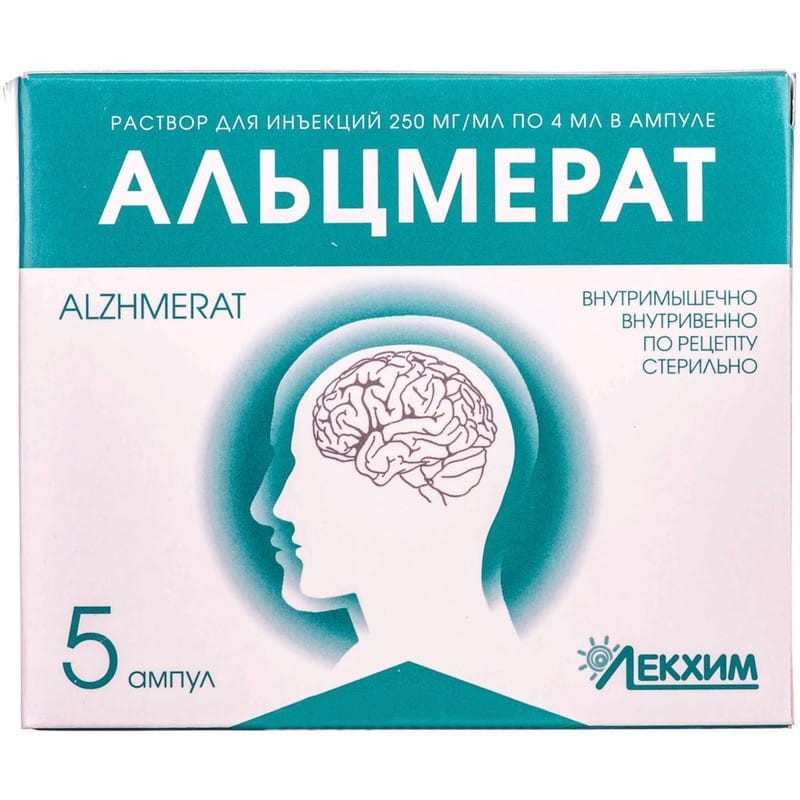



 Secure and encrypted payment processing
Secure and encrypted payment processing We ship to over 40 countries including the USA, UK, Europe, Australia and Japan
We ship to over 40 countries including the USA, UK, Europe, Australia and Japan Guaranteed refund or reship if you haven't received your order
Guaranteed refund or reship if you haven't received your orderActive ingredient: choline alfoscerate;
1 ml of the solution contains choline alfoscerate 250 mg;
excipient: water for injection.
Injection.
Basic physical and chemical properties: colorless or yellowish transparent liquid.
Means that affect the nervous system. parasympathomimetics. choline alfoscerate. code atx n07a x02.
Alzmerate is a drug that belongs to the group of central cholinomimetics with a primary effect on the central nervous system. Alzmerate as a choline carrier and the previous phosphatidylcholine agent has the potential ability to prevent and correct biochemical damage, which is of particular importance among pathogenic factors of the psycho-organic involution syndrome, that is, it can affect the reduced cholinergic tone and the altered phospholipid composition of the membranes of nerve cells. 40.5% of the drug consists of a metabolically protected choline. metabolic protection provides the release of choline in the brain. Alzmerate has a positive effect on memory functions and cognitive abilities, as well as on indicators of emotional state and behavior, the deterioration of which was caused by the development of involutional brain pathology.
The mechanism of action is based on the fact that when choline enters the body, alfoscerate breaks down under the action of enzymes on choline and glycerophosphate: choline takes part in the biosynthesis of acetylcholine, one of the main mediators of nervous excitation; glycerophosphate is a precursor of phospholipids (phosphatidylcholine) of the neural membrane. Thus, Alzmerat improves transmission of nerve impulses in cholinergic neurons; positively affects the plasticity of neuronal membranes and receptor function. Alzmerat improves cerebral blood flow, enhances metabolic processes in the brain, activates the structure of the reticular formation of the brain and restores consciousness in traumatic brain damage.
Pharmacokinetics When administered, on average about 88% of the dose is absorbed. The drug accumulates mainly in the brain (45% of the concentration of the drug in the blood), lungs and liver. Withdrawal of the drug occurs mainly through the lungs in the form of carbon dioxide (CO2) Only 15% is excreted in urine and bile.
An acute period of severe traumatic brain injury with a predominantly stem damage level (impaired consciousness, coma, focal hemispheric symptoms, symptoms of damage to the brain stem).
Degenerative-involutional brain psycho-organic syndromes or secondary consequences of cerebrovascular insufficiency, that is, primary and secondary mental disorders in the elderly, which are characterized by impaired memory, confusion, disorientation, decreased motivation and initiative, decreased ability to concentrate; changes in the emotional sphere and the sphere of behavior: emotional instability, irritability, indifference to the environment; pseudomelancholy in the elderly.
Hypersensitivity to the drug or to its components.
During pregnancy and breastfeeding.
Psychotic syndrome, with severe psychomotor agitation.
Clinically significant interaction of the drug with other drugs has not been established.
The drug is contraindicated during pregnancy and during lactation.
The drug does not affect driving and working with other mechanisms.
In acute conditions, alzmerate is administered intramuscularly or intravenously (slowly) in 1 g (1 ampoule) for 15 to 20 days. then, after stabilization of the patients condition, they switch to the dosage form of the drug in capsules.
There is no experience with the use of alzmerate in children.
In case of an overdose of choline with alfoscerate, which can be manifested by nausea, the dose of the drug should be reduced. symptomatic therapy.
As a rule, the drug is well tolerated even with prolonged use. nausea (which is mainly the result of secondary dopaminergic activation) is possible, abdominal pain and short-term confusion are very rare. in this case, it is necessary to reduce the dose of the drug.
Possible reactions at the injection site. During the first days or weeks of treatment, such manifestations of adverse reactions may occur: anxiety, agitation, insomnia. These symptoms are temporary and do not require discontinuation of treatment, but a temporary dose reduction is possible.
Hypersensitivity reactions are possible, including rash, itching, urticaria, angioedema, and redness of the skin.
3 years.
Store in the original packaging at a temperature not exceeding 25 ° C. Keep out of the reach of children.
It should not be used in the same container with other medicines.
4 ml per ampoule; 5, 10 or 100 ampoules in a pack, or 5 ampoules in a blister; 1 or 2 blisters in a pack.
On prescription.
Private joint-stock company "lekkhim-kharkov".
Ukraine, 61115, Kharkiv region, Kharkiv city, Severin Pototsky street, 36.